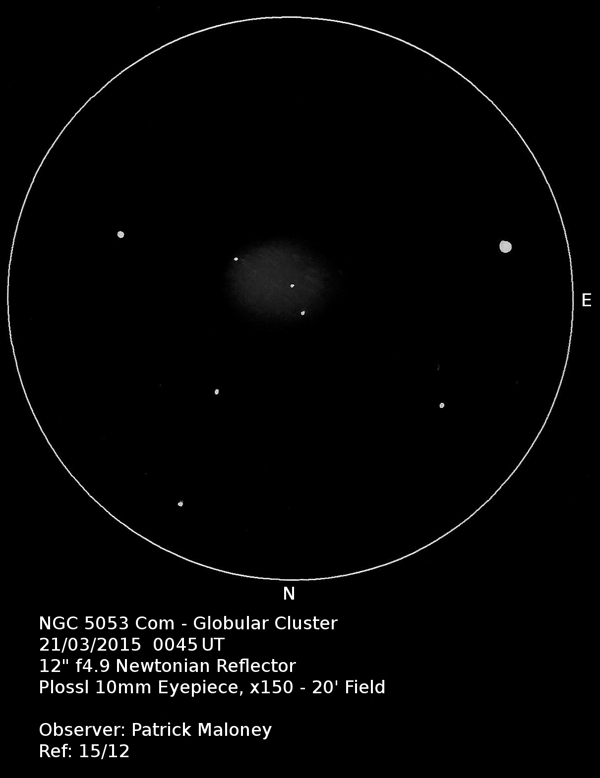NGC 5053 in Coma Berenices
April 2022 - Nebula and Cluster of the Month
In the northern hemisphere, April is a time for observing galaxies as the great galaxy fields of Leo, Coma and Virgo straddle the meridian. Yet April also brings some examples of another class of objects into view. Globular clusters. The brightest of these for northern hemisphere observers (for in the south, the glorious Omega Centauri also culminates this month), is Messier 53. This is a lovely object, well seen even in small telescopes.
However, it is not M53 that we’re going to concentrate on, but its neighbour, NGC 5053. First observed by William Herschel on 14 March 1783, he described it as An extremely faint cluster of extremely small stars with resolvable nebulosity. 8 or 10’ diameter. Verified [with a magnification of] 240. Beyond doubt.
He placed it in his sixth class of objects – ‘very compressed and rich clusters of stars’ as entry no. 7.

NGC 5053 lies less than a degree southeast of M53. The distances of the two globulars are very similar, from which it has been calculated that they lie only about 2kpc (6,500 light-years) apart. Evidence that the two globular clusters have interacted in the past is presented by a tidal stream of stars that connects the two.
Chemically, the stars of NGC 5053 have low metallicity, that is, they are poor in elements heavier than Helium. The chemical composition of the member stars is very similar to that of the stars of the Sagittarius Dwarf Spheroidal Galaxy (SDSG) and far less akin to those of stars in the Milky Way’s halo. Studies of the spatial velocity of the globular cluster add weight to the argument that NGC 5053 was originally a globular cluster of the SDSG, and not of the Milky Way at all.
Whilst M53 may present little difficulty to the visual observer with a small telescope, NGC 5053 is a completely different matter. It is fainter than M53, magnitude 9.9 as opposed to M53’s 7.7. It is also slightly smaller, with a diameter of 10.5’ compared to M53’s 12.6’.
Finally, and much more importantly, whilst M53 has a concentration class of V, NGC 5053’s concentration class is XI, making it a very loosely compacted cluster. I’ve said it before and I’ll say it again, the most important metric for determining the visibility of a given globular cluster is its concentration class.
All this means that seeing NGC 5053 can be tricky. When searching for a low-concentration globular cluster, it’s best not to expect to see a fuzzy ball, as brighter ones tend to appear at low magnification. It’s far better to search for a scatter of very faint stars, although on a good night NGC 5053 itself does present as a faint fuzzy patch. With my 12” Newtonian reflector, from an admittedly poor sky location, I certainly did not see it the first time I looked. When I looked for it after the sky had been washed by a particularly heavy rainfall, I finally saw it.

I saw a large, circular patch of dim nebulosity. There was no indication of brightening towards the centre (typical of low-concentration globulars). It looked more like a ghostly grey patch. Three stars were bright enough to be plotted. It turns out the brightest star in the cluster is magnitude 13.8. Other stars were seen, or glimpsed, but never clearly enough or for long enough to plot.
| Object | RA | Dec | Type | Magnitude |
|---|---|---|---|---|
| NGC 5053 | 13h 16m 27s | +17° 41’ 55” | Globular Cluster | 9.9 |